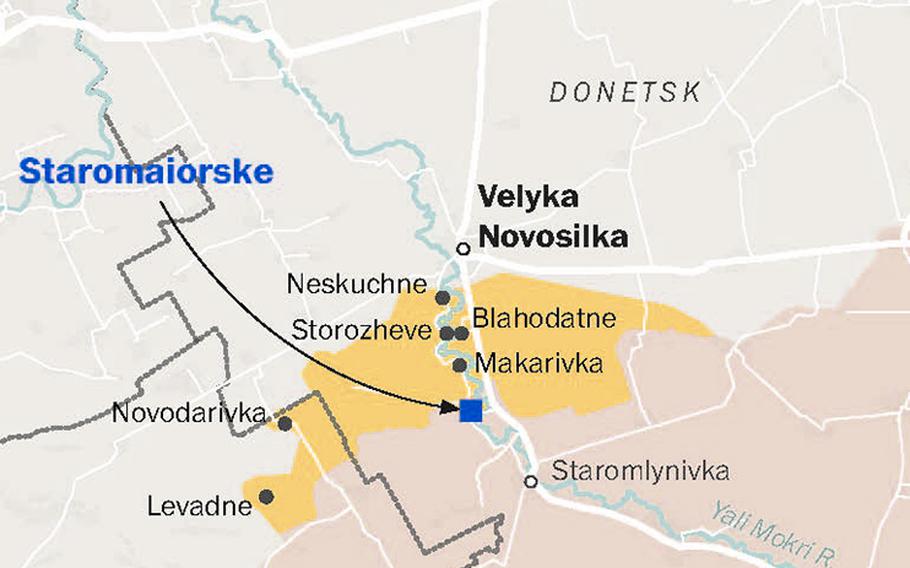Europe
On southern front, Ukrainian forces aim to smash through Russian defenses
The Washington Post July 27, 2023
KYIV, Ukraine — Intense fighting raged along Ukraine's front lines Thursday, according to officials in Kyiv, as Ukrainian troops made slow but steady gains in their ongoing counteroffensive to drive a wedge through the Russian-occupied south.
To the south of the eastern city of Bakhmut — which fell to Russia in May after months of vicious fighting — Ukraine's deputy defense minister, Hanna Maliar, said Kyiv's forces were "gradually moving forward." North of the city, Ukrainian troops were "repelling enemy attacks," she said.
"Battles are quite tough," Maliar wrote in a post on social media. "The enemy is firing intensively."
Meanwhile, Ukrainian President Volodymyr Zelensky posted a video on his official Telegram channel late Thursday that showed soldiers from Ukraine's 35th Brigade claiming to have liberated the village of Staromaiorske, in the Donetsk region.
If confirmed, it would be the first village retaken by Ukrainian forces in weeks — a much-needed victory for Kyiv and a grim reminder of how much hard fighting is ahead.
On Wednesday, Ukrainian officials said their forces made advances south of Orikhiv in the southeastern Zaporizhzhia region, in a drive to reach the Sea of Azov, which would sever Moscow's land bridge to occupied Crimea and limit Moscow's ability to move troops and equipment.
A month and a half into the long-awaited counteroffensive, there are concerns in Kyiv and in Western capitals over the slow pace of Ukraine's advances. Ukrainian officials have vowed to press onward, despite what they say is a lack of air cover and long-range artillery.
U.S. National Security Council spokesman John Kirby said Wednesday that the Ukrainians "are moving, it's not a stalemate," but acknowledged that Zelensky "has said that it's not progressing as fast as he would like."
Zelensky visited the southeastern city of Dnipro on Thursday, where he met with military commanders and discussed updates from the front lines, supplies of munitions to troops and reinforcing air defenses.
Oleh Kiper, head of the Odessa regional administration, said Thursday that Russian missiles hit port infrastructure in an overnight attack. It was the latest barrage in Russia's campaign to destroy Ukraine's ability to export grain after Moscow's recent withdrawal from an agreement to provide safe passage for ships transporting Ukrainian agricultural products. The attack killed a security guard and damaged equipment at a cargo terminal, Kiper said.
Russian President Vladimir Putin said Thursday that fighting had "substantially intensified" in recent days, particularly in Zaporizhzhia, echoing extravagant, and unconfirmed, Ministry of Defense claims about Ukrainian losses.
Speaking at a summit with African leaders in St. Petersburg, Putin said that Ukrainian forces had "suffered the heaviest personnel losses, over 200 people," as well as more than 50 military vehicles including 26 tanks and 13 armored combat vehicles.
"At no point in the fighting has the enemy had any success," Putin said. "[They were] driven back with heavy losses."
Putin conceded that Russian forces hadn't "avoided losses, either, unfortunately."
"But the difference is colossal. The enemy has lost over 10 times more than we have," he said, though he did not provide evidence for his claims.
In its daily report on the conflict, the Institute for the Study of War (ISW) in Washington said Ukrainian forces had "launched a significant mechanized counteroffensive operation" in Zaporizhzhia and appeared "to have broken through certain pre-prepared Russian defensive positions south of Orikhiv."
Russian and Ukrainian officials also said intense fighting was taking place around the town of Robotyne, six miles south of Orikhiv. ISW quoted Russian sources as saying Ukrainian forces launched an "intense frontal assault" toward Robotyne and "[had broken] through Russian defensive positions" northeast of the town.
But Yuriy Sak, an adviser to the Ukrainian Defense Ministry, said the fighting did not represent a major escalation.
"This offensive has been going on for quite some time," Sak said by telephone. "It's no different from other days. As soon as something big happens, we'll know very quickly."
American officials said the movement of additional Ukrainian forces to the Zaporizhzhia region could be a sign that fresh troops are being sent to probe Russian lines or are being deployed to replace fatigued units.
Dara Massicot, an expert on the Russian military at the Rand Corp., said she was concerned that Ukraine could be deploying troops it had held in reserve before breaking through Russia's first line of defense.
"The reserves were intended to exploit an opening, not be a battering ram to create one," Massicot said, cautioning that Ukraine had not achieved a "major breakthrough" anywhere along the front line since the counteroffensive began in early June.
Massicot added, however, that there were signs that Russian troops in Orikhiv had been worn down after weeks of fighting. One of the most experienced Russian units there, the 58th Combined Arms Army, recently lost its commander after he criticized Moscow's military strategy, according to an account by the commander posted to Telegram.
"If the Ukrainians are putting new fresh troops and if they can break through, then they can use their advantage in armored vehicles to gain a lot of territory," said Mark Cancian, a retired Marine officer and defense expert with CSIS, referring to the more advanced vehicles that Ukraine has received from its Western allies.
Dixon reported from Riga, Latvia, and Taylor from Washington. The Washington Post's Isabelle Khurshudyan in Kyiv and John Hudson in Odesa contributed to this report.

(The Washington Post)